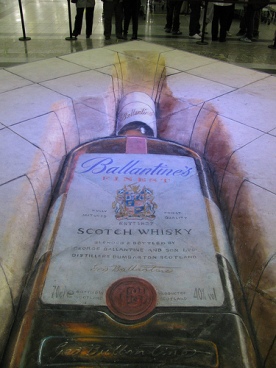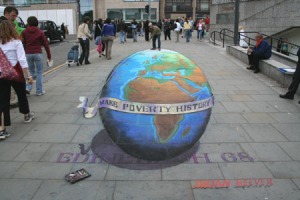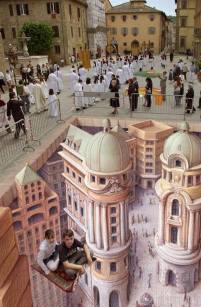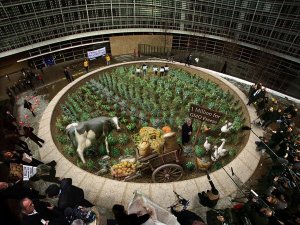This is a TRAVELING art exhibit.
Please make sure to wear your walking shoes.
Post Modernists seek to challenge some of the factors that had come forth in the evolution of Modernism– specifically referencing the avant-garde and paradox that embodied the era. Post Modern artists tend to take styles from previous eras and blend them together, completely redefining the styles original intention. Artists use humor, imitation, and irony rather than one firm stance, in order to protect critique and revision of the art from taking place.
Julian Beever is a great example of this Post Modern mentality. He is a well-known British artist whose canvas of choice is… none other than… pavement. His pieces are often light-hearted and humorous and always unique. He graduated from Art at Leeds Met. University and began painting on pavement in the 90s.
Beever speaks of his beginnings and inspiration– “I got started when I was in a pedestrian street in Brussels where an old garden had been removed. This left an unusual rectangle of paving slabs which gave me the idea to convert this in to a drawn swimming pool in the middle of the high street! It worked so well I tried other variations such as a well with people falling in. I soon realized that if you could make things appear to go into the pavement you could equally make them appear to stand out of it.”
In his early days of pavement painting, Beever focused on well-known men and women in order to draw attention, but after gaining recognition, his focus shifted to fulfilling commissions from corporate businesses and political campaigns.
A couple interesting things to note as we prepare to view some of Beever’s work..
- His pieces are drawn with chalk and are therefore washed away in the rain.
- His pieces only appear 3-dimensional when viewed from the perspective of a camera at a specific angle.
Beever created “Meeting Mr. Frog” in Salamanca, Spain. The year is not documented. As you see, this piece depicts an over-sized frog in a pond on top of a lily pad. The little girl in this photo is not part of Beever’s chalk artwork, rather; it is Beever’s daughter. She is often seen posing in his artwork. The utilization of an actual person in the piece brings the perspective to another level. It allows us to visualize the size and 3-dimensionalism of the piece more accurately. The details of the flowers appear to pop out of the piece, as well as the frog itself. The ripples in the pond bring a new level of dimension for the viewer.
Ballantine’s wanted in on the fun and commissioned Beever to chalk up a piece for the “Leave an Impression” campaign. Beever definitely left an impression, all right! “Leave an Impression” became a play on words, as Beever illustrated the bottle to be literally making an impression in the ground. The piece was completed on December 18, 2009 and would be present until Christmas (so long as it did not rain, of course.) The Ballantine Scotch Whiskey bottle was displayed at the Hearthrow airport in London. His use of detail is impeccable. The shadowing of the impression in the ground, the realness of the bottle’s seal, and the matte finish of the label, definitely make this a notable piece. Here is a photo of an actual Ballantine’s Whiskey bottle:
“Make Poverty History” is another campaign that Beever was requested to shed light on; however, this campaign was more political than commercial. Live8 contacted Beever to chalk up this image with the hopes that it would draw a lot of attention. And draw attention it did. Over 225,000 were able to observe this piece in July of 2005, in Edinburgh, Scotland– not to mention the amount of people that would be able to view the piece online due to the fact that, despite the inevitable disappearance of the piece, a photo lasts forever. Notice Beever himself standing on the top of the earth, giving even more dimension for the viewer to take in. The shadow and the ribbon take this piece to the next level, as they add an even more realistic perspective to the entire piece.
————————–
Kurt Wenner is another well-known 3-D pavement artist. He may be best known for his employment with NASA (drawing conceptual art); however, his street art not only is a crowd favorite, but was the inspiration for Julian Beever himself. Wenner is from the United States but has spent a lot of time in Italy further developing his trade. He was first commissioned to do an art piece at the age of 16. He utilizes a computer program to map out the 3-D images before painting them. Like Beever, his painting are often used for personal inspiration, business advertisement, or political campaigns.
Wenner’s “Flying Carpet” is an astonishing piece that was displayed in Bettona, Italy in 2009. The two children on the “flying carpet” really exaggerate the 3-Dimensionalism of the piece. Notice the people on the city grounds seem hundreds of yards away. The building appear to go above the grounds of Bettona. It is as if an onlooker could jump on one of the buildings and climb down– or join the two children for a magical ride.
Dunkin Donuts commissioned Wenner to do this piece in 2006. It was displayed in Boston, Massachusetts. This photo is particularly humorous as the Dunkin Donut employees are huddled around. The use of butterflies (with strawberries in the middle), bananas, and a picnic blanket, allow the viewer to imagine the fresh and summery flavors that may be noted in the smoothie. The banana peels may be the best part of this one. This piece is great for advertisement!
“Greenpiece- Million Signatures” was chalked up in Brussels, Belgium. This is an example of Wenner’s ability to draw attention to political issues. In this piece we see a man holding a sign that says “1 Million for GMO Sieze.” This piece was used as a grounds for other protesters to stand on with their signs. This specific piece does not seem to be quite as 3-Dimensional as the previous chalk pieces I have noted above, but it does still get the point across.
Here is a clear shot that allows you to see some of the joining protestors.
In this exhibit we have taken a look at two very unique 3-D painters who have used their art not only for personal use, but to help in advertisement as well as political campaigns. This proves that art can go beyond oneself and help further the causes of others. The uniqueness of these artists definitely stands out in a crowd and leaves a lasting impression on all who see it.
Rogers, Mike. “Pavement Chalk Artist: The Three-Dimensional Drawings Of Julian Beever.” Library Journal 136.3 (2011): 107. Academic Search Premier. Web. 28 July 2015.
Lappe, Steve. “Masterpieces In Chalk.” Arts & Activities 139.5 (2006): 20-21. Academic Search Premier. Web. 28 July 2015.
Wenner, Kurt. “Pavement Gallery.” Kurt Wenner. N.P., N.D. Web. 28, July 2015 http://kurtwenner.com/pavement_gallery_1.html
Beever, Julian. “Julian Beever’s Official Website.” Julian Beever. N.P., N.D. Web. 28, July 2015 http://www.julianbeever.net/
“3D Pavement Illusions By Kurt Wenner.” Bored Panda RSS. N.P., N.D. Web. 28, July 2015 http://www.boredpanda.com/3d-pavement-illusions-by-kurt-wenner/









Wow, Julian Beever’s chalk art takes what we did as kids to a whole new level. I like that his works are not only for viewing but can also be interactive. People can jump on the lily pads and take photos of themselves in a new world. It’s okay for them to interact with the art piece because he was intentionally made so that it wouldn’t last for more than a day or two. It’s almost a little sad that sidewalk art doesn’t last long. The art almost takes on two different forms, first its chalk art and then it becomes a photograph. I would love to see some sidewalk art in the city that I live in. In addition to illusion art on sidewalks, artists are creating entire scenes for people to enter when walking down an outdoor staircase or alley. Check out some of these illusion walls on Pinterest https://www.pinterest.com/pannayadi/illusion/
LikeLike
Alana,
Firstly, I’d like to say that I really enjoyed your take on the post modern blog this week and I also really appreciate the type of artwork that you chose. I personally had a harder time finding artwork with a common theme, so I was looking forward to seeing what everyone else chose!
The ground artwork you chose is very neat and spectacular. You mentioned that it’s done with chalk, which leads me to believe that these artists are creating art not for it to last, but for the mere fact that they enjoy what they’re doing. I like the fact that they are solely creating art for fun and for the public even though it’s going to wash away. In a way, it’s refreshing because these artists are creating art even though they aren’t really benefiting from it in anyway.
Let’s not forget that we also have to appreciate these artists artistic abilities. It’s one thing to create art on paper or a canvas, but to create huge murals of ground art in such a way that it looks realistic with perfect angles and 3D is very cool in my opinion.
I’d have to say that Wenner’s Flying Carpet is my favorite. I love how it looks as if there is a hidden city beneath the ground.
Great job this week Alana! Again, I really enjoyed the originality and creativity of your post this week.
Bethany
LikeLike
Awesome post! I thought you did a really nice job tying in post modernism to your theme! And I loved the creativity in your post! I love these chalk pieces! I totally agree with what Bethany said above. Chalk does not last long at all so they created these pieces for pure enjoyment. I think my favorite piece was the “Flying Carpet”. It is amazing how real it looks and the detail put into it! All of the pieces you providing are excellent and fit into your theme really well. 🙂 I also really enjoyed looking and reading about the other pieces provided in the Bored Panda source you provided.
LikeLike
Awesome blog! I really love the 3D pavement art because It looks so real and really put the talent of the artist in perspective. I have always thought this type of art really fascinating to watch the artist as he progressed through the piece from start to finish. I especially like the “Flying Carpet” because looking at it make you feel like you really are floating above the city and the detail is incredible. The Dunkin Donuts piece is a great and vibrant piece too and really drive the brain cray because I know that these drawing are on pavement but my eyes refuse to see it that way. Here is a great video of chalk artist Tracy Lee Stum from California which give a little behind the scenes look at chalk art as well as some of her fantastic chalk art achievements. Enjoy!
LikeLike
Wow! Who new that 3D art was such an extensive are style? I think that the art you displayed in your exhibit has been some of the most elaborate in interesting art I have seen so far. I have an appreciation for the chalk art because of its temporary nature. To me, this suggests that life is really about those moments in which somethings is truly spectacular. This link has some interesting 3D Tattoos that stretch the imagination. http://www.dose.com/lists/16723/24-Insane-3D-Tattoos-That-Will-Completely-Trip-You-Out-ab731-3
LikeLike